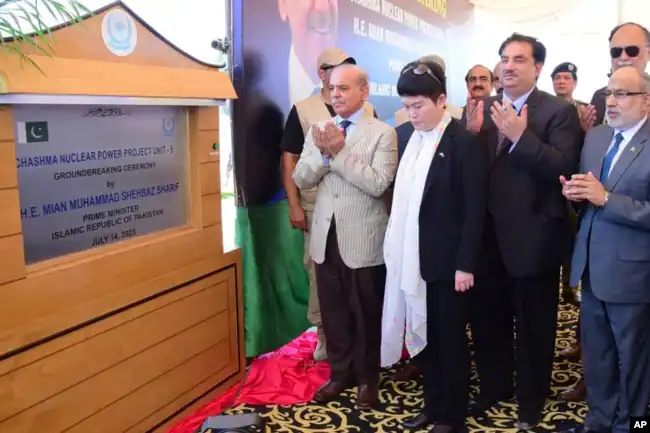(CTN News) – Pakistan and China held a momentous groundbreaking ceremony for the Chashma-5 nuclear power plant, marking a significant milestone in their bilateral cooperation.
This article explores the joint venture, highlighting the importance of this project and its potential impact on Pakistan’s energy sector. The collaboration showcases China’s advanced Hualong One nuclear technology and demonstrates a model of international cooperation for other countries to emulate.
The Significance of Chashma-5:
Largest Civil Nuclear Power Plant in Pakistan: Prime Minister Shehbaz Sharif and senior Chinese officials attended the ceremony in Chashma, emphasizing the historic nature of the project.
Chashma-5, known as C-5, is poised to become Pakistan’s largest generation-III plus nuclear power facility, contributing 1,200 megawatts of electricity daily to the national grid. This development underscores the enduring partnership between China and Pakistan in the field of nuclear energy.
Hualong One Technology:
China’s Contribution to Advanced Nuclear Power Generation: The Chashma-5 plant will utilize China’s domestically developed Hualong One or HPR1000 third-generation pressurized water nuclear technology. This advanced technology boasts enhanced safety features and foolproof security measures. With over 17 Hualong One units under construction in China, the groundbreaking ceremony for C-5 represents a significant milestone for the global journey of this cutting-edge nuclear technology.
The Future of Pakistan’s Energy Sector:
Chashma-5’s Role in Cheap and Clean Energy: Completing the Chashma-5 project by 2030 will bring Pakistan closer to its goal of producing 8,800 megawatts of cheap and clean energy. The nuclear power plant aligns with the country’s efforts to promote clean, efficient, affordable energy solutions. It is anticipated that Chashma-5 will reduce Pakistan’s reliance on fossil fuels and diversify its energy mix.
China’s Nuclear Energy Cooperation with Pakistan:
A Global Example: China’s accelerated civil nuclear cooperation with Pakistan is integral to the China-Pakistan all-weather strategic cooperative partnership. This partnership strengthens bilateral ties and highlights China’s HPR1000 reactors, developed by the China National Nuclear Corporation (CNNC). The success of this collaboration positions China as a global player in advanced nuclear equipment manufacturing.
Belt and Road Initiative and China-Pakistan Economic Corridor:
Power Infrastructure Development: The Chashma-5 project is part of China’s Belt and Road Initiative and the China-Pakistan Economic Corridor (CPEC). In addition to nuclear power plants, CPEC has facilitated the construction of coal-fired power plants, road networks, highways, ports, and industrial zones in Pakistan. These developments, supported by Chinese investment and soft loans, are aimed at boosting infrastructure and stimulating the Pakistani economy.
Economic Concerns and Loan Rollovers:
Impact of CPEC on Pakistan’s Financial Landscape: Critics have raised concerns about the economic implications of CPEC, attributing Pakistan’s deepening economic troubles and depleting foreign exchange reserves to this initiative. Pakistan’s external debt, including loans from China, constitutes a significant portion of its financial obligations. Some experts argue that the repayment of Chinese loans, including those from power plants, poses challenges for Pakistan’s economy.
Positive Economic Impact and Job Creation:
Pakistan’s Perspective on CPEC: While there are concerns, Pakistani and Chinese officials contend that CPEC has played a pivotal role in stimulating the economy and generating employment opportunities. The project has reportedly created nearly 200,000 local jobs since its inception a decade ago. Proponents of CPEC emphasize its long-term benefits and its potential to address infrastructure gaps in Pakistan.
Financial Challenges and IMF Bailout:
China’s Support in Difficult Times: Pakistan faced economic challenges, including declining foreign exchange reserves and fears of default on external payments. In this context, China’s support has been crucial. China recently rolled over several billion dollars worth of loans, demonstrating its commitment to helping Pakistan navigate these challenging times. Such support has been instrumental in securing a much-needed $3 billion bailout from the International Monetary Fund (IMF).
Nuclear Cooperation:
A Civilian Focus and Adherence to International Safety Standards: Both Pakistan and Chinese officials maintain that their nuclear cooperation is limited solely to civilian purposes.
They emphasize that Pakistan’s civilian nuclear plants adhere to the safety guidelines of the International Atomic Energy Agency (IAEA). This commitment to international standards ensures the safe operation of nuclear facilities and reinforces the peaceful nature of their nuclear collaboration.




